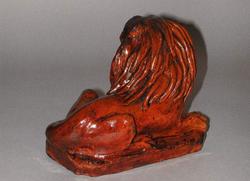Current Location: Gallery 27 (Glaisher)
Titles
Lion (facing left)
Maker(s)
Pottery:
Pill Pottery
Potter:
Davies, H.
(Probably)
Entities
Categories
Description
Earthenware figure, moulded, modelled additions and lead glazed.
Red earthenware lion lying with left front paw raised on a ball, head turned to the left and tail curled over the left rear foot. The cheeks are incised to suggest whiskers and the mane is thickly modelled. The lion rests on a flat rectangular base which has rounded corners. The front of the base is incised ‘H. D [indecipherable]. The underside is open, mainly unglazed.
Notes
History note: Bought at Sotheby’s on 12 June 1906, lot 177, for 10/- (ten shillings) with its pair, by Dr J.W.L. Glaisher, FRS, Trinity College, Cambridge.
Legal notes
Dr J.W.L. Glaisher Bequest
Measurements and weight
Height: 16 cm
Acquisition and important dates
Method of acquisition: Bequeathed
(1928-12-07)
by
Glaisher, J. W. L., Dr
Dating
19th Century, Mid
Circa
1850
CE
-
1860
CE
Note
Pill Pottery, thought by Dr Glaisher to have been near Bristol, is now known to have been in South Wales, at Pillgwenlly, Newport. The factory, which appears in Kelly’s Directory of 1801, mainly made bricks and tiles.There were several later Newport potteries. Examples of figures are rare and seem mainly to have been made in glazed red earthenware, like these. Pill Pottery lion pairs occasionally appear at auction and a group of Samson slaying the lion is held by the V&A (C.216-1922).
The signature on this lion is probably that of Hambury or Humbury Davies, first recorded at the Pill Pottery in 1848, and in 1852 having a second pottery in Commercial Road. By 1865 these had passed into the possession of Evan Davies.
This is one of a pair of lions, perhaps made to sit at either end of a mantelpiece or dresser. As each has a paw raised on a ball, they are probably based on a pair which were moved from the gardens of the Villa Medici in Rome to public display at the entrance of the Loggia dei Lanzi in Florence, in 1789. Small scale reproductions of the Medici lions in stone, marble, plaster and bronze were widely circulated, and the potters may have used these as models, rather than engravings of the originals. Pottery lions were popular in the early 19th century, although more often produced in white earthenware and decorated with coloured glazes or enamels; there are several in the Fitzwilliam collection.
People, subjects and objects depicted
Components of the work
Decoration
composed of
lead-glaze
Base
Depth 9.6 cm
Width 18.5 cm
Parts
Materials used in production
Red earthenware
Techniques used in production
Moulding
: Red earthenware, moulded and modelled, lead glazed
Inscription or legends present
- Text: H. D [unclear]
- Location: Front of base
- Method of creation: Inscribed
- Type: Mark
- Text: No. 2422. Lion of red glazed pottery (one of a pair) marked H. Davies Pill Pottery b. at Sotheby’s June 12, 1906, lot 177.
- Location: Inside base
- Method of creation: Rectangular paper label handwritten in black ink
- Type: Label
References and bibliographic entries
Identification numbers
Accession number: C.182A-1928
Primary reference Number: 72722
Old object number: 2422
Stable URI
Audit data
Created: Saturday 6 August 2011
Updated: Tuesday 27 August 2024
Last processed: Tuesday 15 July 2025
Associated departments & institutions
Owner or interested party:
The Fitzwilliam Museum
Associated department:
Applied Arts

 IIIF Manifest
IIIF Manifest







